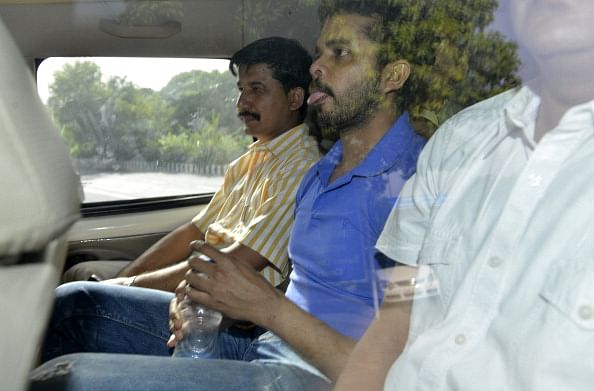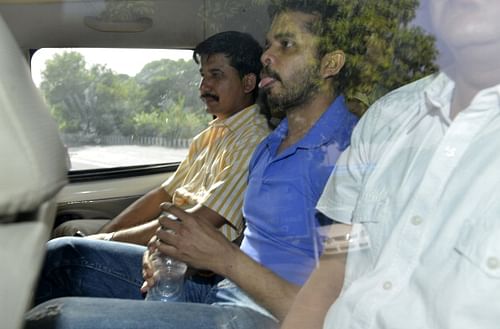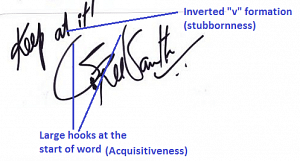
Why successful people do a 'Sreesanth': Some insights from analysing his signature

“Sreesanth” is not an official phrase yet, but I thought to use “Sreesanth” as a metaphor for the people who have achieved great things fairly quickly in life, but still somehow found a way to stumble and fall to disgrace. Indian Pacer S Sreesanth is cynosure of the Indian media’s eyes these days because of his alleged involvement in the spot-fixing controversy in the IPL.
Let me narrate two instances in the recent times that shook me to disbelief.
Rajat Gupta was one of the most cherished success stories of corporate America. With a career spanning multiple decades, he was one of the most respectable names, often seen as an epitome of professionalism. In March 2011, the S.E.C. charged him in the largest insider trading case in the history of the United States. His sentencing was a jaw-dropping moment for the world, given the solid reputation he had earned over the years. The other factor that made the whole saga unexplainable was coming to acceptance with the fact that a person of Gupta’s stature, who was worth more than $100 million dollars, was involved in cheating just for gaining a few more million dollars. It was his past reputation that made big names like Bill Gates, Kofi Annan and Mukesh Ambani write to the judge to show some leniency in the verdict. It is said that some members of the jury were seen weeping after passing the judgement. Even the best in business suffer from what Rajat later called an “error of judgement”.
The second instance that is dominating the headlines these days is related to spot-fixing. Sreesanth, who has represented India, and was a part of two World Cup-winning teams, was nabbed by Delhi police on the charges of fixing a portion of a few IPL matches. The instance of spot-fixing is not new, but what’s surprising is that a person involved in the national team did it. The national team players in India are more than handsomely paid through contracts, and also for all the attention the players get, they become the face of many products via heftily-priced advertisement contracts. For instance, in the Indian Premier League, his franchise paid him around INR 2.2 crores per season spanning close to 2 months, which is more than a lot of money. For a person to still indulge in spot-fixing despite earning so much would really take a different kind of motivation.
An intriguing question:
These two stories are similar in some ways and dissimilar in other ways. Dissimilar because both Rajat and Sreesanth belonged to different professions. Rajat was at the fag end of his career and had worked hard to establish his reputation when he was caught in insider trading, whereas Sreesanth was more often in news for wrong reasons and didn’t have a stellar reputation. He was more or less at the middle of his career.
The similarity of both these instances lie in the sheer stupidity of their act despite having achieved so much monetarily and otherwise. Some moments of bad thinking set them on a path of failure, causing almost irreparable damage to their reputations.
A more intriguing question for me in these episodes is: Why would people ever think of getting into such an act after reaching the peak in their careers?
Its a hard question to answer but one quote from Mahatma Gandhi probably would help put things in perspective.
“Earth provides enough to satisfy every man’s needs, but not every man’s greed’”
The keyword here is “greed”. And these cases prove that greed sometimes plays a more dominating role in the minds of people who have achieved great things in life.
Sreesanth’s signature:
For this analysis, I had to rely on the signature sample available on the internet. I do not trust these public samples often, but the traits I am going to list were found in various versions of Sreesanth’s signature sample available on the internet, so we could be assured that this is pretty accurate.

Does greed show up in Sreesanth’s signature?
One of the traits that is significantly prominent in Sreesanth’s signature is his desire to acquire or ‘acquisitiveness’. Greed, in a way, is a function of acquisitiveness in one’s personality. This is represented with the kind of hook formation at the start of the letter. In his signature, it can be found in the starting “S” of his first and last name.
The desire to acquire need not always be bad as, being human beings, there is a need to have some ambition to acquire things or knowledge. However, an excess of anything is bad, and the same could be thought of as true in the case of Sreesanth. In the numerous signature and handwriting samples that I have seen and analysed, I have hardly seen any person having such big hooks at the start of a word. That certainly is a proof of something excess at play here; and when any trait is in excess, it often causes problems in behaviour or general response to many life situations.
If I have to make an informed guess about the pressure exerted while writing the signature, I would go for high pressure. High pressure is often treated as a ‘trait intensification portion’ of handwriting or signature.Trait intensification portion means that the presence of these portions in the handwriting usually intensifies other aspects of the personality. If we add this fact to the excessive desire to acquire, we get a person who could do go out of this way to gain materialistic pleasures.
Another interesting observation from Sreesanth’s signature is the presence of stubbornness in his personality. Stubborn people are more braced towards their own ideas, and don’t want to be confused with the facts after their mind is set on something. Stubbornness is actually a defense mechanism. It develops from the subconscious fear of being wrong. Stubborn people think that they are right all the time. With this defense mechanism in place, Sreesanth would have turned down the voice of any external person who would have tried to show him the right path once he set his mind on doing something wrong.
Final thoughts:
The world that we live in today often teaches us to learn hard from failures and become better. But as these cases prove, more than failures, successful people could do well to learn to handle success better as well. Most of the ills in the world come from the inability to handle success.